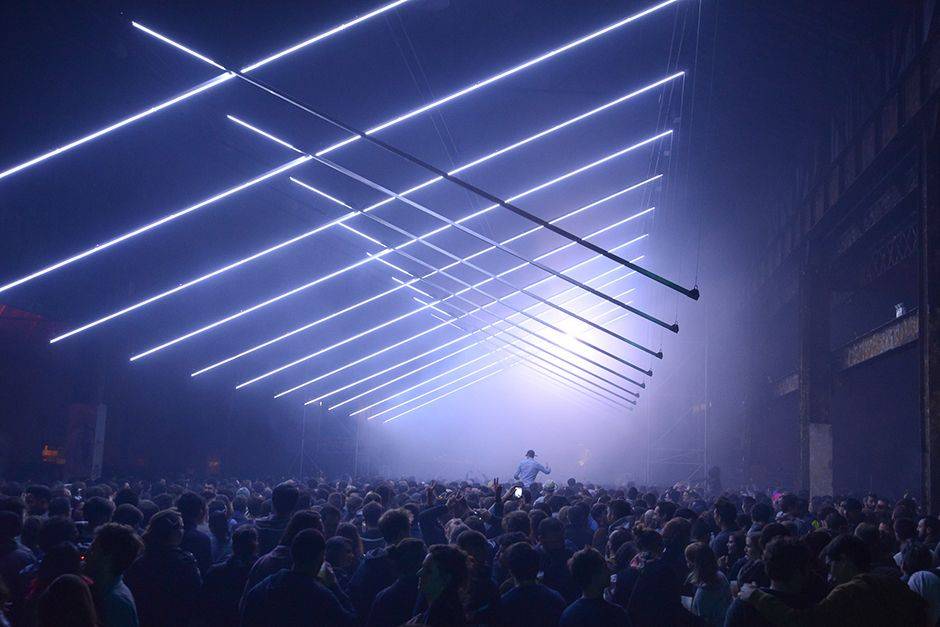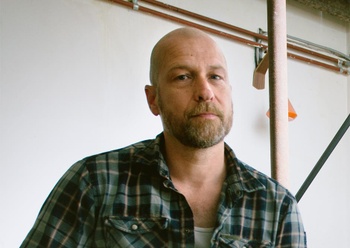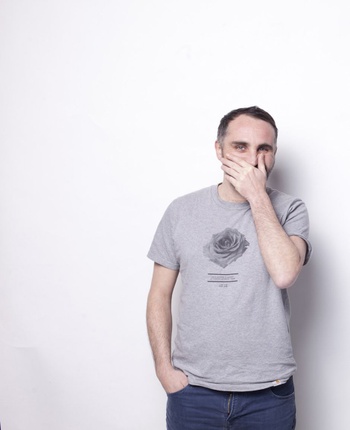“It has finally got through to everyone that we don’t just organise parties,” says Pierre-Marie Oullion. For the last fifteen years, he has helped to put together the line-ups for Nuits Sonores, a festival cum urban laboratory that is coming to Brussels for the first time soon. Close collaboration with the Bozar Electronic Arts Festival demonstrates that what began life in a suburb of Lyons has made a definitive breakthrough to the heart of Europe.

© Anne Simmonot
Bozar Electronic Arts Festival teams up with Nuits Sonores
"We have actually been exploring the relationship between electronic music and contemporary art right from the beginning,” says Pierre-Marie Oullion, recalling, for example, the way Nuits Sonores has worked to find new uses for abandoned industrial heritage. In Lyon, they transformed an old sugar refinery into the base for their five-day festival and a cultural hotspot that benefits the whole Confluence district. “Once a building is a bit moribund, or is between two activities, we like to get involved. That’s part of the ephemeral dimension of our project.”
It sounds as if being long-standing is something for the permanent collections in museums, whereas electronic music, because of its young, lively character, must of necessity be fleeting and flexible. According to Oullion, the greatest strength of the festival – which has grown over the last decade and a half into one of the major events of the European electronics scene – is its exploratory approach, both in artistic and urbanistic terms.
For outsiders, the link now established with Bozar in Brussels – following a number of other foreign connections – might seem a bit odd. The two organisations have quite different dynamics. Bozar is an institution. Nuits Sonores has developed from the bottom up over recent years, consciously opting for a nomadic existence and investing in offering ideas via workshops rather than within a scholarly framework. But it is precisely those differences that have now led to the development of mutual curiosity and complementarity. BRUZZ brought Oullion face to face with Marc Jacobs, who is responsible – for the sixth time – for the musical side of the Bozar Electronic Arts Festival (BEAF).
Can the two of you sketch the contexts within which the two festivals took shape?
Pierre-Marie Oullion: In the late 1990s, Lyons was one of the least electronica-friendly cities in France. There was serious repression of techno parties. Raves were cancelled or obliged to turn off the music at midnight. With all that opposition, the landscape was pretty barren at the beginning of this century. And that was when Vincent Carry, the founder of the festival, threw himself into the breach.
He drew his inspiration from the mayor of Barcelona, who had been very positive about the influence the Sónar Festival had had on the development of his city since 1994. We saw a great opportunity to reinvent the old rave culture and to mix it with contemporary elements over a five-day independent event. We approached all the cultural institutions too at the time.
It turned out that they had a completely false image of electronic music. At the opera house they just laughed at us. Well, they had to revise that later. Our first edition, in May 2003, attracted 15,000 dance enthusiasts. Recently, the fifteenth edition had a record 140,000 visitors.

© Heleen Rodiers
The BEAF is six years old now. DJ Darko in Brussels had already paved the way by organising two editions of the Brussels Electronic Music Festival at Bozar. The focus then was entirely on music. Later, the BEAF made connections with Bozar’s other disciplines and the Centre for Fine Arts made as many different spaces available as possible so as to shed light on a broad array of electronic music and digital culture.
So a lot has happened over the last decade and a half.
Oullion: Indeed. Thanks to our structure, we have developed special partnerships with a number of high-profile cultural venues. Electronic music culture is now an integral part of their programming. It is the living art, the beating heart, of the contemporary arts. It was no accident that the Musée d’art contemporain [the MAC in Lyons] was the first “institution” to support our event. You shouldn’t underestimate the significance, in that evolution, of a Europe that is caught up in an identity crisis and that finds it very hard to engage in a dialogue with young people.
Our way of working, which I often compare to how a newspaper or a magazine is put together, means that we are in a much stronger position to develop a discussion with young people. More and more, we see ourselves as a sort of re-animator of European things that have gone awry or as a young citizen alternative for a Europe that is mainly focused on economic aspects.
Back in 2013, you devoted a “carte blanche” to the Brussels music scene. Why are you now organising a festival as well?
Oullion: Back then, we turned the spotlight on Brussels because the city helped us to tell our story. And it still does today. In terms of its dynamics, size, and population, moreover, the city is a bit like Lyons. I have also noticed that people here deal with the issue of integration in a much more relaxed way.
African music and hip hop find their way into the institutions easily. That fits in with the identity of the city. In France, the cultural institutions have done a much worse job of coping with the multicultural. For the structure behind Nuits Sonores and our European Lab, the European dimension is important too. Our presence here also reinforces our international structure, which now has 35 projects.
Why do the Nuits Sonores complement the BEAF?
Jacobs: In terms of the music, the Nuits Sonores programme is that bit more festive. They are more familiar with dance floor culture. We also organise concerts for a seated audience. By working together, we can now put more emphasis on the acoustics and the visual arts, while they are breathing new life into places elsewhere in the city, something that we at Bozar don’t have the know-how for.
The most important Nuits Sonores concerts and DJ sets are taking place in Palace 10 at the Heizel/Heysel, while your European Lab has fetched up in ADAM, near the Atomium. Why?
Oullion: Our presence in Palace 10, a space that was never used for music before [Palace 12 was designed for that – TP], does indeed fit in with our ambition to keep on getting into new places. In any case, mindful of our trajectory in the Confluence district in Lyons, we saw it as important to pick an area that was going to be completely rethought over the next few years.
During what we call a “Hackatlon”, a workshop in which cities share their practical experience of restructuring with each other, we will reflect in more depth on a new dynamic for the Heizel/Heysel district. That kind of discussion increases people’s involvement in the city.

© Ghislain Mirat
Jacobs: Musically, it has been noticeable for some time now that electronic music has found its way into other genres. It has become the norm, in a sense, from EDM to avant-garde. One consequence of that is that we can see the same thing happening in electronica as in rock: at times people look back and there are revivals, of industrial techno for example, and noise is now even being assimilated by artists from the mainstream. That is leading to a lot of hybrid forms. One important aspect for a festival like the BEAF is that VJs have now become visual artists.
Oullion: VJ-ing has turned out to be just one stage in the collective electronica experience. A single screen is no longer enough. So the person programming events has become more important now. He helps to create the total dimension, the global fusion between the digital signal, music, and image. The scene’s most important challenge, in my opinion, is actually at the social level.
Electronic music has often been the first to put an issue on the map and it could now take the lead in the gender debate too, one of the last major struggles that still have to be sorted out. I’m in favour of openly taking up the debate with artists who come out with homophobic and macho language, as there is a danger of earlier emancipatory work being undone.
Jacobs: I agree completely.
Is this the start of a long-term association?
Jacobs: If Nuits Sonores were to decide to stay in Brussels, then it seems obvious to me that we would continue to cooperate. But we also have to wait and see how the city reacts to their presence. And we must consider what “September electronica month” could mean for Brussels in the long term.
Oullion: We’re not here for one shot. Our presence here is important symbolically. It has gradually got through to everyone that we don’t just organise parties. That we have become an economic and a social player, as well as an artistic one, is a victory in itself.
> Nuits Sonores. 14/09 > 17/09, various locations
> Bozar Electronic Arts Festival. 14/09 > 30/09, Bozar, Brussels
NUITS SONORES
The city as a lab
Nuits Sonores is not only organising two consecutive dance nights at Paleis/Palais 10, with Modeselektor and Laurent Garnier topping the bill, the festival will also have a palpable presence in the city centre.
The opening party will take place on Thursday 14 September at (and with) Bozar. That same night, there will be Circuit concerts at the AB, the Bonnefooi, the Fuse, and Le Brass, where Islam Chipsy & EEK will play enchanting Egyptian techno trance and the Brussels label Rebel Up! is guaranteed to make you dance. In Lyons, the Circuit evening is always the busiest, since it is the organisers’ anchor to pull in potential audiences.
The off-road section Extra! highlights the festival’s itinerant character, with a Queer Dance party, a Hammam Disco, and an aperitif with creative entrepreneurs at a former industrial laundry. The European Lab, which was founded in the lap of Nuits Sonores, organises workshops and debates at the ADAM, where people explore new cultural dynamism in the wake of urban and European transformations.
The closing party is in the hands of the DJ of Camion Bazar, which will be parked at Flagey on Sunday afternoon and evening.
BOZAR ELECTRONIC ARTS FESTIVAL
The motto is: multidisciplinary
In keeping with their tradition, the musical zenith of the Bozar Electronic Arts Festival will occur during the last weekend of September.
The organisers have attracted some impressive names, like the American drone master William Basinski, who will be paying tribute to David Bowie, and the Icelandic composer Jóhann Jóhannsson.
But we’re also looking forward to the performances by the Japanese Phew and the Australian Ben Frost. To amp up the anticipation, you can visit the installations of the laureates of the STARTS Prize 2017 or the multidisciplinary exhibition Tendencies. Six female Belgian artists are engaging in dialogue with the latest digital technology.
The greatest innovation is that the Estonian exhibition The Archaeology of the Screen is the first in a new space for media art. Bozar Lab will be inaugurated officially during the opening of the Bozar Electronic Arts Festival and it will further explore the link between art and technology. That same evening, an exclusive performance by David Behrman will commemorate the controversial concert that the young American avant-garde collective The Sonic Arts Group played here 50 years ago. At that time, electronic culture had not yet been introduced to the centre.
Read more about: Brussel-Stad, Muziek, Events & Festivals
Fijn dat je wil reageren. Wie reageert, gaat akkoord met onze huisregels. Hoe reageren via Disqus? Een woordje uitleg.